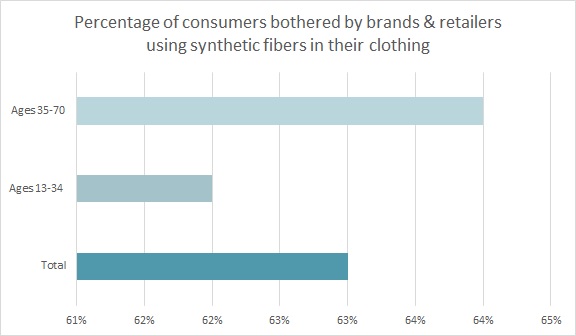Earth is called the Blue Planet because it’s covered mostly in water. And since 1993, World Water Day has been held every year on March 22 to “celebrate water and raise awareness of the 2 billion people living without access to safe water.”
They have deeply entered our food chain, of which we are at the top, so the risk for us is even higher.”
Laura Diaz Sanchez
The Plastic Soup Foundation
One of the threats that puts the world’s water supply at risk is directly related to the fashion industry: synthetic/manmade textiles, materials that are forms of plastic. California’s Ocean Protection Council says plastic production has risen exponentially, with 11 million metric tons estimated to wind up in the oceans and waterways each year due to the rapidly increasing levels of plastic pollution. Additionally, a report from the International Union for Conservation of Nature (IUCN) estimates 229,000 metric tons of plastic leak into the Mediterranean Sea alone each year. This amount is equivalent to 500 shipping containers of plastic per day. The IUCN says most of the microplastic pollution comes from tire dust (53 percent) followed by textiles at 33 percent.
Laura Diaz Sanchez manages the Ocean Clean Wash campaign for The Plastic Soup Foundation, a non-profit marine conservation organization aimed at reducing plastic pollution. In an article, she explains that “when these textiles are manufactured, washed with your laundry, worn, or dried, they release these tiny plastic fibers in the water and air.”
“These microfibers have been found in almost everything we eat and drink: fish, seafood, chicken, tap water, bottled water, salt, beer,” Diaz Sanchez states. “They have deeply entered our food chain, of which we are at the top, so the risk for us is even higher.”
The Plastic Soup Foundation points out that the reason there is so much microfiber pollution floating in the waters is that, unlike natural fibers, manmade/synthetic textiles are a form of plastics — and plastics are not biodegradable.
Research shows that a switch to cotton would likely be welcomed by consumers. Two in five shoppers (40 percent), up from 35 percent in 2021, say they are aware that microfibers from clothes are polluting the world’s oceans and water, according to the Cotton Incorporated 2022 Lifestyle Monitor™ Survey. Nearly two-thirds (65 percent) who are aware of microfiber pollution, say this realization will affect their future clothing purchase decisions.

Further, the majority of consumers (62 percent) say they are bothered by brands and retailers using synthetic fibers in their apparel — specifically because of microfiber particles entering the waterways, according to the Monitor™ research. Most (55 percent) say they would be more likely to check fiber content labels before purchasing something new to avoid buying clothes made from synthetic fibers due to their concern over plastic microfiber pollution.
Cotton starts as a plant and naturally biodegrades when its fibers enter the environment. Brands looking to meet their sustainability goals can be reassured that researchers from Cotton Incorporated and Cornell University have demonstrated that cotton is compostable and will biodegrade faster than synthetics on land. Additionally, researchers from Cotton Incorporated and North Carolina State University have determined that raw cotton microfibers are able to decompose faster than polyester in fresh water, salt water, and water treatment facilities.
For instance, in one biodegradability test, just 21 percent of a cotton garment remained after a month in fresh water, versus 100 percent of a polyester garment. Additionally, after 32 days in saltwater, 52 percent of a cotton garment remained, compared to 96 percent of a polyester piece. One can conclude that a switch by brands and consumers to cotton clothing can reduce the amount of microplastic pollution in the planet’s waterways.
Over the years, various designers and brands have touted their use of recycled polyester or recycled plastic bottles that have been turned into polyester. However, as an article from Première Vision, the fashion and textile show, points out, “whether recycled or not, polyester generates plastic microparticles during each wash, microparticles which are released in the wastewater and then into the oceans. Secondly, polyester can’t be infinitely recycled because recycling causes it to lose strength and quality. As of now, it is still quite complex to design a recycled polyester product without the addition of virgin material.”
At the point of sale, over 2 in 5 consumers (43 percent) say fiber content is the most beneficial factor for determining how long an article of clothing will last, according to Monitor™ data. Compared to synthetic fiber clothes, consumers say cotton clothing lasts the longest (59 percent). They also say cotton is the most sustainable (76 percent) and offers the highest quality (71 percent).
As industry brands and makers consider what can be done to improve the planet’s waterways while reducing microplastic pollution, the World Water Day organizers will be releasing the UN World Water Development Report. The theme of this year’s World Water Day focuses on the importance of groundwater. Organizers describe groundwater as “a hidden treasure that enriches our lives. Our drinking water and sanitation, our food supply and natural environment — all these rely on groundwater.
“Groundwater has always been critically important but not fully recognized,” the organization states. “We must protect groundwater from pollution and use it sustainably, balancing the needs of people and the planet.”
